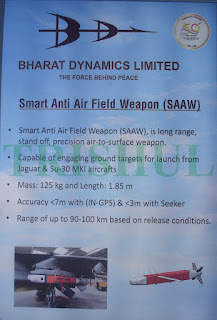At first glance, the most
obvious improvement on the Indian Navy’s first Project 15B guided-missile
destroyer (DDG) INS Visakhapatnam is the inclusion of the TERMA/TATA Aerospace
& Defence-supplied X-band Scanter-6002 multi-function surface-search radar
that does away with the earlier Russia-origin 3TS-25E Garpun Bal-E (built by JSC
Concern Granit-Electron), which still exists on board the Project 17 FFGs,
Project 15 and Project 15A DDGs, plus the Project 1241RE Molniya FAC-Ms and
Project 25A corvettes.
And above the helicopter hanger in the stern section can
be the 12.7mm remote-controlled weapon stations that were supplied by Israel’s
ELBIT Systems and the former Ordnance Factory Board (OFB).
So, the principal RF-based
radars on board INS Visakhapatnam are the EL/M-2248 MF-STAR S-band multifunction
active phased-array radar, the THALES-BEL RAWL-02/PLN-517/LW-08 L-band
air-search radar and the Scanter-6002 surface-search radar that will provide
fire-control cues for both the OTOBreda/BHEL 76/62 SRGM and the BrahMos-1
supersonic anti-ship cruise missiles.
However, over the years, a
wide variety of radars from different OEMs have entered service. For instance,
the three Project 17 guided-missile frigates (FFG) have the MR-760 Fregat M2EM D/E-band
multifunction radars, EL/M-2238 STAR air-search radars, and the 3TS-25E Garpun Bal-E
surface-search radars for target engagement with Novator 3M54E supersonic
anti-ship cruise missiles, and the EL/M-2221 STGR radars for the SRGM’s
fire-control.
The three Project 15A DDGs use
the EL/M-2248 MF-STAR S-band multifunction active phased-array radars, THALES-BEL
RAWL-02/PLN-517/LW-08 L-band air-search radars, and the 3TS-25E Garpun Bal-E
surface-search radars for target engagement with BrahMos-1 supersonic anti-ship
cruise missiles and for fire-control of the 76/62 SRGMs.
The six Project 1135.6 FFGs
imported from Russia use the MR-760 Fregat M2EM D/E-band multifunction radars, 3TS-25E
Garpun Bal-Es Mineral-ME radars for surface-search, and the Ratep JSC 5P-10E
Puma fire-control system for AK-176 naval guns. The last is now being replaced
by the Lynx-U2 NGFCS for fire-control of the retrofitted 76/62 SRGMs on board
the three Batch-1 Project 1135.6 FFGs (after their mid-life refits).
The four Project 28 ASW
corvettes make use of the Revathi S-band air-search radar (replacing the earlier
MR-352 Positiv-E surface-search radars) and Lynx-U2 NGFCS (for the 76/62 SRGMs),
as do the Project 1241RE Molniya FAC-Ms and three Project 25A corvettes.
The
IAC-1 aircraft carrier uses the RAN-40L air-search radar supplied by SELEX
Sistemi Integrati (subsidiary of the Leonardo Group) and the EL/M-2248 MF-STAR
radar, while the seven Project 17A FFGs will have on board the EL/M-2248
MF-STARs and the 3-D all-digital LTR-25 L-band air-/surface-search radars
supplied by Spain’s INDRA.
However, an impressive degree of commonality has been achieved in the arena of electronic warfare with the fleet-wide installation of the Nayan COMINT suite, Shakti jammer suite, the Varuna ESM suite, the Maareech torpedo decoy suite, the Kavach countermeasures dispenser suite and the ORBIT-supplied RUKMANI naval VSATs for Data-Linking.
The Project 15B DDGs are also the third warship-types to be built with DMR-249A steel, with the first being the IAC-1, followed by the four Project 28 ASW corvettes.
































































